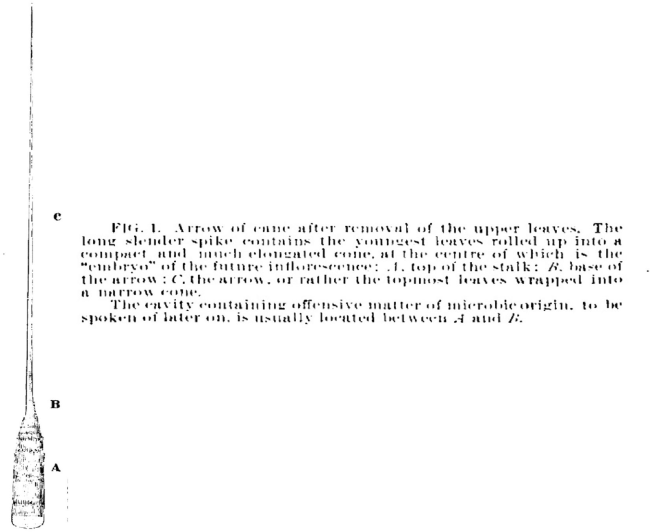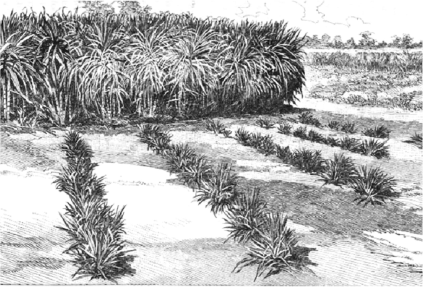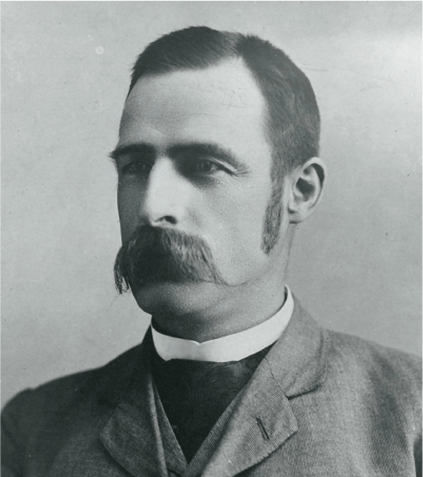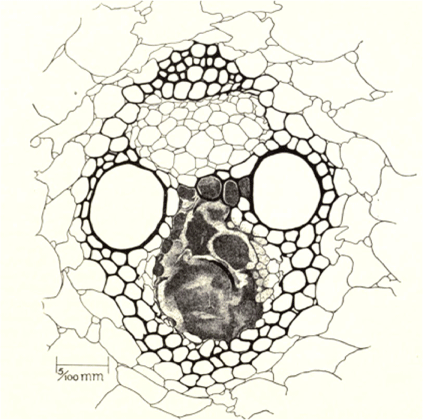The discovery of gumming disease of sugarcane in Australia
Malcolm J. Ryley A *
A *
A
Abstract
Sugarcane is one of Australia’s major agricultural industries, with approximately 95% of the crop being grown in Queensland and the remainder in northern New South Wales. In the last decade of the nineteenth century, cane growers in northern New South Wales started to see a new disease that resulted not only in the death of plants but also in difficulties in the extraction of sugar. Theories about the cause abounded, but investigations by the New South Wales vegetable pathologist Nathan Cobb revealed that the disease, previously unknown to the world, was caused by a microbe in the creamy ‘gum’ that could be commonly found in the vascular tissues of affected stalks. He named the organism Bacillus vascularum (now known as Xanthomonas axonopodis pv. vasculorum). For some time after, the disease was known as ‘Cobb’s gumming disease of sugarcane’. The Australian bacteriologist Robert Greig-Smith was not convinced that Cobb had conclusively demonstrated that B. vascularum was the culprit, mainly because he did not satisfy Koch’s Postulates. However, the American bacteriologist Erwin Frink Smith came to Cobb’s rescue when he proved beyond doubt that B. vascularum was to blame. The disease is now known simply as ‘gumming disease of sugarcane’.
Keywords: Australia, bacterium, disease, Erwin Smith, Greig-Smith, gumming, Nathan Cobb, sugarcane, Xanthomonas axonopodis pv. vasculorum.
Introduction
In the early 1890s, canegrowers along the Clarence and Richmond Rivers in northern New South Wales were becoming increasingly alarmed about a new disease (‘checked arrowing’) that had appeared quickly and was spreading rapidly. The term ‘arrow’ refers to the arrow-shaped panicle of sugarcane after its emergence, but prior to then it is enveloped by the tightly-compacted, partly-expanded, upper leaves of the stalk (botanically, a culm) (Fig. 1). ‘Checked arrowing’ occurs when panicle emergence is inhibited for some reason.
Drawing of an ‘arrow’ of cane with leaves removed, showing the top of the stalk (a) base of arrow (b) and arrow consisting of the ‘topmost leaves rolled into a cone’ (c) the rotting and gumming started between a and b, after Cobb (1905), fig. 1, https://babel.hathitrust.org/cgi/pt?id=hvd.hxj1jc&view=1up&seq=126&q1=GUMMING.

In this paper, I provide an overview of the various theories that growers and others had about the cause of the new sugarcane disease, discuss the research undertaken by the New South Wales vegetable pathologist Nathan Cobb (1859–1932), then cover the work of two scientists, Australian Robert Greig-Smith (1866–1927) and American Erwin Frink Smith (1854–1927) who conclusively proved that the bacterium isolated from affected stems was the cause of the disease. I have used newspaper articles (https://trove.nla.gov.au/), books, and scientific papers as sources of information.
Early investigations on the disease
In the affected northern New South Wales sugarcane crops not only were the upper parts of the stalks dying, but the crushing of diseased cane and extraction of sugar was adversely affected. A newspaper article on 28 October 1891 stated that samples sent to the Department of Agriculture, New South Wales (‘The Department’) the previous year (1890) had not provided a satisfactory solution and that various management methods suggested by growers had been tried and found to be useless.1 The article also reported that Mr John Bale of Chatsworth had noted that 10 min after cutting affected stalks, the running sap turned yellow, ‘like cream’, but the most obvious symptom of the new disease was the dying of stalks from the top.2
There were many opinions about the nature and cause of the new disease. Mr F. Pastourel, a sugar boiler and distiller from Queensland, believed that the soil and not the cane plant was diseased, due to being impoverished from continuous planting of cane.3 He suggested that diseased fields should be ploughed, manured and planted with fresh cane. On the other hand, borers that entered at the stalk bases and found their way to the top were blamed by Mr M. H. Samson of the Harwood Sugar Mill.4
The affected growers were becoming anxious about the disease and the apparent lack of action on the part of The Department. One writer implored The Department to fully investigate the problem, believing that ‘theorists, amateurs, or learners in the art and science of Agriculture will certainly not inspire that confidence’. The article also noted that some believed the cause of the disease was a grub, but planters with more than twenty years of experience had said ‘no’.5
However, ‘amateur’ diagnosticians could not be silenced. Officers of the Colonial Sugar Refining Company (CSR) believed that the problem was due to a combination of hot weather before October 1891 (that caused some varieties to ‘arrow’), while later cool weather stopped the development and resulted in rotting of the upper part of the stalk. The officers maintained that it was not a ‘fungoid or organic disease’.6 After inspecting diseased crops Dr Kottman, who was ‘connected’ with CSR, stated that it was caused by lack of drainage, shallow cultivation, ‘exhaustion of vegetable matter’, and carelessness in the selection of planting material.
The Department responded by sending at least three officers in 1892 and 1893 to the Clarence and Richmond Rivers to investigate the cause of the disease and to recommend control strategies. These officers were Jean Marie Adrian Despeissis, Mr O’Kelly (both inspectors of agriculture) and Mr A. Sidney Olliff, government entomologist. In 1893 Mr Angus Mackay, an instructor at the Sydney Technical College, also visited the district to provide his opinion of the cause and management of the disease.
Despeissis (1892) provided details of the sugarcane disease found in sugarcane growing regions of the northern rivers of New South Wales, in particular in the valleys of the Clarence, Richmond and Tweed Rivers. He described the symptoms as a withering, stunting (Fig. 2) and ultimate death of the top parts of the stalks, shooting of the buds at the top of the stalk, internally red patches of tissue spreading from the buds up and down the stalk and rotting of the roots.7 He had sent samples to ‘the plant pathologist’ (presumably Nathan Cobb, the New South Wales vegetable pathologist) who found that there was no ‘widespread’ fungus. Despeissis concluded that the disease was caused by insects including the clavicorn beetle (probably the fungus-eating Brachypeplus binotatus) that burrowed into the stalk and induced local fermentation of the tissue, the resulting poison spreading throughout the stalk. O’Kelly wrote a report of his findings in the same issue of the Agricultural Gazette of New South Wales and also concluded that borer insects were the most likely cause, attacking the top of the plant and working their way down the stalk.8 He provided further details of the symptoms, noting that the older leaves ‘closed up’ at the top of the stalk and the inner, developing leaves (a symptom that he called arrowing) became twisted and distorted before dying.
Drawing of sugarcane stools planted from healthy (background) and diseased setts (foreground), After Cobb (1905), fig. 11, https://babel.hathitrust.org/cgi/pt?id=hvd.hxj1jc&view=1up&seq=151&q1=GUMMING 109.

O’Kelly reported from farmers’ observations that plants grown from setts (a short section of stalk usually including two nodes, that is used for planting) taken from cane with arrowing resulted in diseased plants, whereas setts taken from cane without symptoms resulted in healthy plants. O’Kelly recommended that drainage of sugarcane fields be improved, planting setts be taken only from healthy plants, stools be ratooned (cut and regrown) only once, the ground be fallowed and different varieties be tried. A year later, O’Kelly discussed the phenomenon of arrowing and ‘checked arrowing’ in some detail. He defined arrowing as a natural phenomenon at the end of the vegetative growth period when a thin ’joint’ 4–5 feet (=approx. 1.2–1.5 m) long is produced at the top of the stalk that is terminated by a panicle.9 He had changed his mind since the previous year and believed that the cane ‘checked arrow’ disorder was due to an interruption of this process by some unknown cause, perhaps cold weather.10
Entomologist A. S. Olliff reported his findings to the Department of Agriculture in March 1893 after visiting the northern rivers district in December 1892 and January 1893. He found six insects including Brachypeplus binotatus in sugarcane crops along the Clarence and Richmond Rivers, but concluded that none were involved in the disease/disorder that was devastating crops.11 Olliff (1893) believed that the continued growing of cane sourced from previous crops may have resulted in deterioration and decay, but he noted that he had found many fungi in the affected cane crops. He recommended that a competent mycologist conduct a thorough investigation.
After completing his investigations, McKay also concluded that a fungus was most likely responsible for the disease. He believed that a fungus in the upper nodes was causing the cell system in the stem to rupture resulting in the death of the stalk above, the ‘saccharine matter’ to become acidic and the gummy matter to be set free, that interfered with the refining process. He stated that he was trying to grow the fungus in his laboratory with the hope of identifying it.12
Apparently, canegrowers were not convinced with any of these diagnoses. At a well-attended grower meeting at Chatsworth in November 1892, it was revealed that in the current season losses as high as 50–75% had been experienced by some growers.13 Inside the affected stalks red blotches could be found in the pith, especially at the joints (nodes) and a yellow, gum oozed from the stalk. Additionally, experiments conducted by growers showed that planting setts cut from healthy stalks produced healthy plants, but setts taken from gummed stalks always produced diseased plants. Obviously frustrated, the meeting attendees resolved that The Department be asked to send a scientist to fully investigate the disease.
Cobb’s discovery
It took some time for the government to respond, and it was not until June 1893 that Dr Cobb (Fig. 3) arrived and was using the Harwood Mill laboratory as his base during his two month stay.14 Within five weeks he addressed over one hundred growers at the Harwood Mill to present his findings. At the meeting he told growers that the new disease, that had never been investigated before, was due to a gummy matter that contained microbes and which blocked the passages (xylem vessels) that carried moisture through the plants.15 Cobb believed that gumming of cane was also present in parts of Queensland, and the following year occurrences of gumming disease of cane were reported in the Bundaberg, Isis and Mary River districts of that state. He had inoculated a healthy stalk of cane but did not yet have a result. Cobb was certain the disease was spread in diseased setts, so careful selection of planting material and crop rotations would be of benefit, as the growers had already decided.
Nathan Cobb, photographer and date unknown, courtesy of Nathan B. Cobb and the American Society of Nematologists.

Cobb sent a report to the Minister of Agriculture in October 1893 and published a paper on the subject in the Agricultural Gazette of New South Wales.16 He had considered thirty possible causes of the disease, including fungi and nematodes, but had concluded that microbes (bacteria) in the gum were the most likely cause, because the microbes were always in the gum, and the gum was always associated with the disease. He stated that the results of inoculations would provide the evidence that was needed and intended to name the microbe Bacillus vascularum because it was found mainly in the vascular tissues and the gum, which he named ‘vasculin’.
In his publication, Cobb began by describing the anatomy and morphology of the sugarcane plant (stool) and stalks. He wrote that at the top of an infected stalk, the arrow would be rotten and cavities at the top of the stalk would be filled with a gummy substance with an offensive odour. A yellow gum oozed from the cut surfaces of stems and a multitude of bacterial cells could be found in the vascular tissue (Fig. 4). He also traced discoloured vascular tissue from the stalks into buds at the nodes. His recommendations were similar to others: namely careful selection of planting material from healthy stalks, improvement of drainage, destruction of infested trash and stools, and the adoption of resistant varieties.
Drawing of a vascular bundle in a diseased stalk, showing bacteria (dark mass) in the central xylem vessel (specimen from New South Wales), after Smith (1914), fig. 19, https://babel.hathitrust.org/cgi/pt?id=uc2.ark:/13960/t3hx17g7h&view=1up&seq=77204.

In the following year, Cobb reported the results of his inoculations. He described in detail the tool that he had developed to inoculate the cane stalks; it consisted of a fine chisel-edged needle to puncture the stalk and a finer needle that had been dipped into the bacteria-containing gum and inserted in the hole made by the chiselled needle.17 Of the six healthy stalks that had been inoculated at Harwood in August 1893 and sent to him almost a year later for examination only four were still alive and all ‘were gummed throughout the culm [stalk]’. The single control stalk had also died. Based on this one experiment Cobb was convinced that Bacillus vascularum was the cause of the gumming disease.
The Australian bacteriologist R. Greig-Smith was not so sure about Cobb’s assertion. He wrote that Cobb’s description of the bacterium was lacking detail and his scant description could have applied to at least eleven described species of bacteria at the time.18 He briefly discussed Cobb’s (1894) inoculation experiment and stated that in all infection experiments purified bacteria (grown on artificial culture media) should be used in inoculations. Greig-Smith considered that although Cobb had demonstrated the gum in infected stalks was associated with the disease he did not conclusively prove that the bacterium in the gum was the cause.
Greig-Smith spread drops of the gum onto various media and purified the bacterium, noting that neutral cane-juice gelatine was the best medium for growth of B. vascularum. He provided a detailed and comprehensive description of the morphology and physiology of the bacterium and compared its physiological characteristics with those of the gum from affected stalks. The reactions of both pure cultures and gum to chemicals such as lead acetate and dilute acetic acid were the same, with Greig-Smith in 1902 concluding that the bacterium was the direct cause of gumming in cane.
In 1905, after moving to Hawaii to become director of the Division of Pathology and Physiology in the Hawaiian Sugar Planter’s Experiment Station, Cobb wrote a bulletin that summarised the information on gumming disease of sugarcane to that date.19 Many of the details in his 1893 and 1894 publications were included, along with information from the papers of Greig-Smith and the American bacteriologist Erwin Frink Smith. The latter scientist had summarised Cobb’s and Greig-Smith’s work as well as the results of his own experiments.20 Stalks with severe gumming were sent to him from New South Wales in 1901 and 1902, but only the later samples had been suitable for research. Erwin Smith posed the question: ‘Were Cobb’s declarations correct, as it seemed, or were they erroneous guesses like so many other pronouncements in matters pathological’.
Erwin Smith and his team purified the bacterium from gum placed on agar media and inoculated two leaves on each of twelve stalks on growing plants (grown from healthy setts) by puncturing them 20–30 times in an area of 4 cm2 with a needle that had been immersed in the ‘gum’ from cultures grown under artificial conditions. He noted that after three weeks white streaks, that later became red-brown flecks and stripes, appeared first on the inoculated leaves and then on other leaves of the stalks. Soon after, all twelve inoculated stalks became stunted and after three months the inoculated and older leaves shrivelled, and the terminal parts became infested with a bacterial rot. He completed Koch’s Postulates by isolating the bacterium from some of these infected stalks and proclaimed that ‘everything was as Cobb described’. In addition, he provided evidence that the variety Common Green Cane was highly susceptible to disease and the varieties Louisiana No. 74 and Common Purple Cane were more resistant, probably because the sap of the latter two varieties was more acidic than the first-mentioned variety. He believed that Cobb’s disease was also in Java, Mauritius and Brazil.
The Australian sugarcane pathologist David North, who worked for the Colonial Sugar Refining Company for over 40 years, considered that ‘the early dissemination of gumming disease from Mauritius to Australia probably occurred about 1874 to the Clarence (region) and 1877 to Bundaberg–Maryborough and Mackay (regions)’.21 If this was the case, gumming disease of sugarcane was probably present in these districts for over a decade at low levels before it was discovered.
Erwin Smith later updated the information on Cobb’s gumming disease, reporting that it was also found in Fiji, Borneo, and Brazil, but probably not in the United States.22 Symptoms and signs of the disease were first reported in Brazil in 1869, and later in Madeira (1886) and in Mauritius (1894) where it had been present for at least fifteen years.23 Smith noted other signs and symptoms of the disease, including the presence of red and yellow vascular fibres, excessive production of buds in the upper internodes and also provided detailed observations of his series of inoculation experiments. He also listed the susceptible and resistant varieties.
After a series of name changes, the current accepted name of the sugarcane gumming bacterium is Xanthomonas axonopodis pv. vasculorum.24 Although it has been reported in countries in Africa, Asia, North and South America and Oceania it is now considered to be a significant problem only in Mauritius and Reunion.25 The Queensland sugarcane pathologist Brian Egan stated that by 1935 gumming disease was no longer a problem in Australia due to the growing of more productive and resistant varieties.26 It is considered to have been eradicated from Australia.27
Conclusions
Was Erwin Frink Smith more lenient on his fellow American Nathan Cobb’s investigations of the gumming disease of sugarcane in Australia than on the work of the Australian Henry Tryon’s study of brown rot of potato, also called ‘Tryon’s disease’ in the first few decades after its discovery? The latter story is told in detail in another publication in this series,28 but in summary Smith rejected Tryon’s claim of priority on the discovery of brown rot of potato (now known to be caused by Ralstonia solanacearum) based mainly on Tryon’s description of the symptoms and his failure to conduct inoculation experiments. I have shown that the first accusation regarding symptoms is baseless, but the second accusation has substance.
By comparison, Cobb successfully inoculated healthy sugarcane stalks with the ‘gum’ from infected stalks, but it was not until Erwin Smith conducted experiments with pure cultures of the bacterium (reported as Bacillus vascularum) that it could be stated definitively that the bacterium was the causal agent of the gumming disease of sugarcane. In my opinion, some of Smith’s concerns about Tryon’s priority claim (and therefore the use of the common name ‘Tryon’s disease’) have substance, but his ready acceptance of Cobb’s work on the gumming disease of sugarcane, especially the less-than-desirable inoculation method that Cobb had used, and his failure to satisfy Koch’s Postulates, was perhaps more lenient.
References
Anonymous (2022) Xanthomonas axonopodis pv. vasculorum (sugarcane gumming disease), Invasive Species Compendium, CAB International, https://www.cabi.org/isc/datasheet/56980, viewed May 2022.
Cobb, N. A. (1893c) Microbe diseases of sugarcane—gumming of cane (Bacillus vascularum): diseases of the sugar-cane plant diseases and their remedies, Agricultural Gazette of New South Wales, 4, 777-799.
| Google Scholar |
Cobb, N. A. (1894) The cause of gumming in sugar-cane, Agricultural Gazette of New South Wales, 5, 683-686.
| Google Scholar |
Cobb, N. A. (1905) Third Report on Gumming of the Sugar-Cane, Division of Pathology and Physiology Bulletin No. 3, Report of Work of the Experiment Station of the Hawaiian Sugar Planter’s Association, https://babel.hathitrust.org/cgi/pt?id=hvd.hxj1jc&view=1up&seq=125&q1=GUMMING, viewed May 2022.
Despeissis, J. A. (1892) Sugar-cane disease on the north coast, Agricultural Gazette of New South Wales, 3, 20-22.
| Google Scholar |
Egan, B. (2015) The History of Cane Pest and Disease Control Boards in Queensland, Brian Egan, Chermside, https://elibrary.sugarresearch.com.au/bitstream/handle/11079/15648/History%20of%20Cane%20Pest%20and%20Disease%20Control%20Boards%20in%20Qld%20Egan.pdf?sequence=2&isAllowed=y, viewed June 2022.
Greig-Smith, R. (1902) The gummosis of the sugar-cane (Bac. vascularum, Cobb), Proceedings of the Linnaean Society of New South Wales, 27, 31-47 https://www.biodiversitylibrary.org/item/29995#page/47/mode/1up, viewed August 2022.
| Google Scholar |
Magarey, R. C., and Croft, B J. (1997) Final Report—SRDC Project BS172S Part II—a Review of Yield Losses Caused by Australian and Selected Exotic Sugarcane Diseases, Bureau of Sugar Experiment Stations Queensland, Australia, https://elibrary.sugarresearch.com.au/bitstream/handle/11079/831/A%20review%20of%20yield%20losses%20caused%20by%20Australian%20and%20selected%20exotic%20sugarcane%20diseases%20%3A%20SRDC%20final%20report%20BS1725.pdf?sequence=1, viewed August 2022.
North, D. S. (1935) The Gumming Disease of the Sugar Cane, its Dissemination and Control, Agriculture Report No. 10, CSR Co. (extended abstract), Sydney, https://www.cabdirect.org/cabdirect/abstract/19361100691
Olliff, A. S. (1893) Report on a visit to the Clarence River district for the purpose of ascertaining the nature and extent of the insect ravages in the sugar-cane crops. Agricultural Gazette of New South Wales, 4, 373-387.
| Google Scholar |
O’Kelly, E. d. P (1892) Report on the sugar-cane disease on the Richmond and Clarence Rivers, Agricultural Gazette of New South Wales, 3, 397-402.
| Google Scholar |
O’Kelly, E. d. P (1893) 'Arrowing' and its relation to the present disorder in the sugar-cane, Agricultural Gazette of New South Wales, 4, 24-30.
| Google Scholar |
Ryley, M. J. (2024) Henry Tryon—the true discoverer of the potato brown rot pathogen, Ralstonia solanacearum, Historical Records of Australian Science, 34, y-z.
| Google Scholar |
Smith, E. F. (1904) Ursache der Cobb’schen krankheit des zuckerrohes, Centralblatt für Bakteriologie, Parasitenkunde und Infektionskrankheiten, 2 Abt. XIII 30, 729-736 https://archive.org/details/centralblattfurbakteriologieparasitenkundeundinfektionskrankheiten.2.abt.band13.1904/page/n769/mode/2up, viewed June 2022.
| Google Scholar |
Smith, E. F. (1914) ‘Cobb’s disease of sugar-cane’, in Bacteria in Relation to Plant Diseases, vol. 3: Vascular Diseases Continued, Carnegie Institute of Washington Publication 27, vol. 3, pp. 3–71, Press of Gibson Brothers, Washington, DC, https://babel.hathitrust.org/cgi/pt?id=uc2.ark:/13960/t3hx17g7h&view=1up&seq=21, viewed June 2022.
Footnotes
7 Despeissis (1892) pp. 21–22.
8 O’Kelly (1892) p. 397.
9 O’Kelly (1893) p. 25.
10 O’Kelly (1892) p. 28.
11 Olliff (1893) p. 374.
12 McKay (1893).
14 Anonymous (1893).
15 Anonymous (1894).
16 Cobb (1893a, 1893b, 1893c).
17 Cobb (1894) p. 683.
18 Greig-Smith (1902) p. 32.
19 Cobb (1905).
20 Smith (1904).
21 North (1935). Egan (2015).
22 Smith (1914) p. 3.
23 Hughes (1961) p. 55. Smith (1914) pp. 3, 5.
24 Smith (1914) p. 69.
25 Anonymous (2022).
26 Egan (2015) p. 10.
27 Magarey and Croft (1997) p. 17. Anonymous (2022).
28 Ryley (2024).


